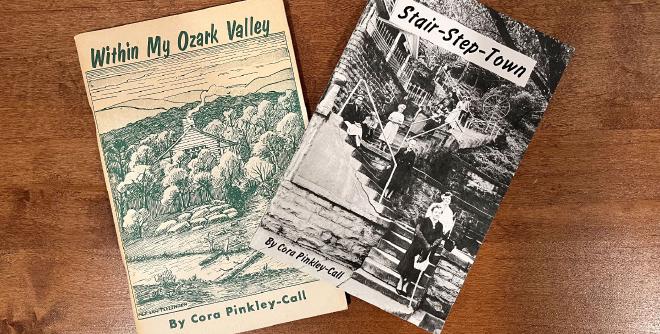
Hog-killing time
These last few months, I’ve been busy wrapping up research and fact-checking for the first half of my upcoming book, Welcome to Eureka Springs: The I-Sh*t-You-Not History of America’s Quirkiest Town.
It turns out Eureka Springs needs a little more of that than usual.
To give an example, Cora Pinkley-Call was the town’s foremost historian for much of the 20th century. Many people remember the shack that sat next to the Eureka Springs Historical Museum for many years – that was a replica of the cabin she liked to write in, using three logs remaining from the original.
As a child, Cora loved the listen to old-timers tell stories of the early days, and she grew up to be one of the first to write them down. Her Pioneer Tales of Eureka Springs and Carroll County in 1930, 1946’s “Stories About the Origin of Eureka Springs” in the Arkansas Historical Quarterly, and 1952’s Stair-Step Town are essential reading for anyone studying the area’s history.
However!
Cora was a proud native preserving the stories of a fading culture, not a scholar. She tended to believe the oral legends uncritically, and wasn’t too picky about getting little details like years exactly right. She just needs a little double-checking here and there.
Thanksgiving brings to mind a story from her 1956 memoir, Within My Ozark Valley.
“Hog-killing time came around at the first real cold snap in the fall, when the geese began going South,” she wrote of her childhood. “How clearly I recall the smell of fragrant pine, cedar and oak as the north wind whipped the smoke from the huge black iron kettle where the water boiled ready to scald the hogs.”
Early settlers of the Ozarks grew, raised, hunted, or fished nearly everything they ate. Store-bought goods were a luxury, often limited to flour, sugar, and coffee.
After slaughter, hogs were plunged into scalding hot water to make it easier to scrape hair off the skin. Most settlers had large kettles for this purpose; Hogscald Hollow got its name because that area’s residents took advantage of the large, natural bowls in its rock instead.
Shoulders, hams, sides, and jowls went to the smokehouse, one of the only ways to preserve them in the days before refrigeration. Heads and extremities were seasoned with vinegar and spices to make pickled pigs feet, what was called souse or head cheese, and scrapple (grease and trimmings combined with cornmeal into a mush, then fried). Tender cuts and more trimmings went into sausage. Organ meats were gifted to neighbors who helped out with the butchering.
“It is no wonder that we had a sense of well-being with a smoke house full of meat and lard, a cellar full of fruits and vegetables, and our barns filled with hay and corn for our animals,” Cora wrote. “I still think the thrifty Ozark farmer lived an ideal life.”
Cora’s truth was the kind that comes from living it. And she knew this was a good time of the year for a feast. Here’s wishing you and yours a cozy Thanksgiving – with or without the scrapple.